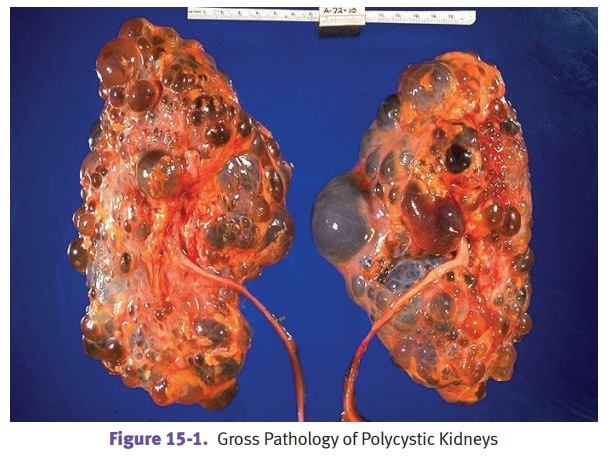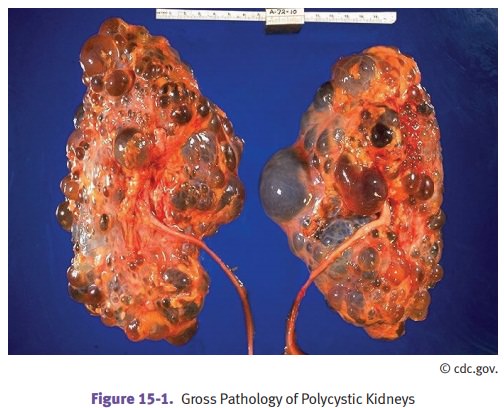Chapter: Pathology: Renal Pathology
Cystic Disease

CYSTIC DISEASE
Autosomal recessive polycystic kidney disease (also called infantile
polycystic kid-ney disease or renal dysgenesis Potter type I) is a rare autosomal
recessive disease that presents in infancy with progressive and often fatal
renal failure. A mutation in the PKHD1
gene is implicated.
The kidneys are bilaterally
enlarged and have a spongelike cut surface. The liver may have multiple hepatic
cysts and cirrhosis may develop in childhood. Pulmonary hypoplasia is present
to varying degrees
Autosomal dominant polycystic kidney disease (also called adult polycystic
kidney disease or renal dysgenesis Potter type III) is
an autosomal dominant disease that affects 1 in 1,000. There is most frequently
a mutation of the PKD1 gene on
chro-mosome 16 which produces a transmembrane protein called polycystin 1.
Other mutations involve PKD2 and
polycystin 2.
Clinically, patients are
asymptomatic with normal renal function until middle age, and then present with
renal insufficiency, renal stones, hematuria, and hypertension or with
abdominal masses and flank pain. Diagnosis is established with U/S and CT scan.
Most patients develop end-stage renal failure by decade 7.
On gross pathologic
examination, the kidneys have massive bilateral enlargement with large bulging
cysts filled with serous, turbid, or hemorrhagic fluid. Microscopic examination
shows functioning nephrons present between the cysts; the cysts arise from the tubular
epithelial cells of the kidney.
Extrarenal manifestations
include cysts of the liver, pancreas, and lungs; berry aneu-rysms of the circle
of Willis; mitral valve prolapse; and colonic diverticula.

Renal dysplasia is the most common renal
cystic disease in children, in whom it causes an enlarged renal mass
with cartilage and immature collecting ducts. It may progress clinically to
renal failure.
Acquired polycystic disease is seen in renal dialysis
patients and is associated with a small risk of developing
renal adenomas and renal cell carcinoma.
Simple retention cysts of the kidney are common in
adults and occasionally cause hematuria.
Medullary diseases with cysts
•
Medullary sponge kidney can cause nephrolithiasis but is otherwise
innocuous.
•
Nephronophthisis-medullary cystic disease complex presents as
polyuria and polydipsia; it can progress to chronic renal failure in young
adults. There are autosomal recessive forms. The cysts are in the cortex and
the medulla.
Related Topics